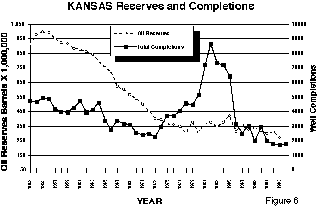
During the 1990's total well completions in Kansas were at levels that were last seen in the 1930's and 40's (Figure 8). At these low rates of completion, the state can expect a continued or accelerated decrease in oil and gas reserves and future production. The increases in oil and especially gas production that are occurring in the state are associated with increased drilling and are concentrated in the Hugoton field and adjoining areas of southwestern Kansas. The oil production from the lower Paleozoic rocks of the Central Kansas uplift continues its decline.
Figure 8--Kansas Reserves and Well Completions. A larger version of this figure is available (full version 12k).
Relatively recent discoveries such as Terry (Finney County, 91 discovery), Big Bow (Grant and Stanton counties, 1989 discovery), Lahey (Stevens County, 1989 discovery), and Heinitz (Kearny County, 1988 discovery) are now among the top 20 fields in the state as ranked by annual production (Table 3b). Schuck Field, a 1955 discovery, is ranked as the number one producing field in 1994 (Table 3b). Schuck Field was unitized in 1990 and placed on waterflood. The response was dramatic with production increasing from 213,644 barrels in 1992 to over a million barrels in 1994. A comparison of the twenty largest fields by cumulative and annual production in 1994 highlights the decreased dominance in terms of current production of the older lower Paleozoic (Arbuckle) fields of the central Kansas uplift, and the increased importance of production from the younger Paleozoic (Lansing-Kansas City, Morrow, and Mississippian) intervals of the Hugoton embayment (Tables 3a and b). This trend is even more dramatically illustrated by the stratigraphic and geographic distribution of the twenty fields that showed the biggest year-to-year increase in production (Table 3c). With only a few notable exceptions increased oil production is associated with the relatively new fields in the upper Paleozoic horizons of southwest Kansas. The dominance of recent discoveries from southwest Kansas indicates that part of the state should continue as a significant exploration and development area and increase its percentage of the state's oil and gas production.
As stated in a previous reports, what remains constant is that the oil and gas industry of Kansas continues to respond to the challenges of the international marketplace and government policy. The oil and gas industry remains, as it has from the late 1800's, an important component of the Kansas economy and way of life.